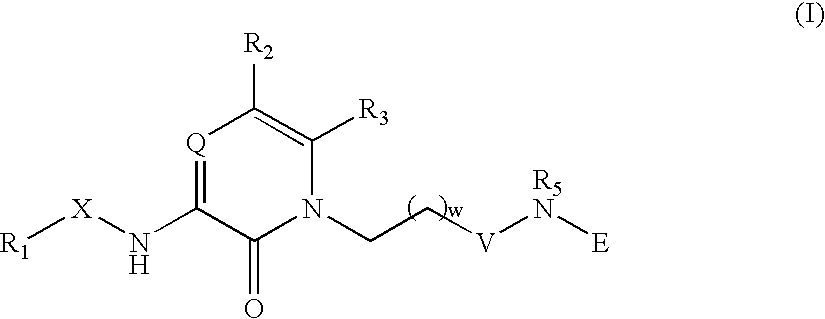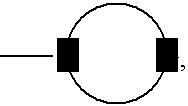Non-convalent thrombin inhibitors
a thrombin inhibitor and non-convalent technology, applied in the field of compounds, can solve the problems of reduced or complete lack of blood flow to the affected organ, poor activation of protein c by thrombin in the absence of thrombomodulin, and reduced blood flow to the affected extremity, so as to inhibit thrombin
- Summary
- Abstract
- Description
- Claims
- Application Information
AI Technical Summary
Benefits of technology
Problems solved by technology
Method used
Image
Examples
example 1
Preparation of 3-Benzyloxycarbonylamino-1-[(2-methoxy-carbonyl)ethyl]-6-methyl-2-pyridinone (1-2)
##STR16##
Methyl acrylate (5.23 mL, 58.14 mmol) was added to a solution of 3-benzyloxycarbonylamino-6-methyl-2-pyridinone (1-1) (10.0 g, 38.76 mmol) and cesium carbonate (3.16 g, 9.7 mmol) in 50 mL of dry DMF under nitrogen. The reaction mixture was stirred at room temperature for 15 hours, then was poured into water (500 mL), and then was extracted with ethyl acetate (800 mL). The organic phase was washed with brine (300 mL), dried over sodium sulfate, and concentrated under reduced pressure. The crude residue was purified by silica gel column chromatography using EtOAc and hexane (2:1) as eluant to afford the title compound 1-2 (7.74 g, 58 % yield) as a light yellow solid. MS (m / e): 345 (M+1).sup.+. TLC: R.sub.f (0.36)(EA / Hex); .sup.1 H NMR (400 MHz, DMSO): .delta. 2.3 (s, 3H), 2.68 (t, 2H), 3.60 (s, 3H), 4.2 (t, 2H), 5.1 (s, 2H), 6.1 (d, 1H), 7.4 (m, 5H), 7.6 (d, 1H), 8.1 (s, 1H)
example 2
Preparation of 3-Amino-1-[(2-methoxycarbonyl)ethyl]-6-methyl-2-pyridinone (1-3)
##STR17##
A mixture of 1-2 (7.74 g, 22.5 mmol) and 10% palladium on carbon catalyst (0.93 g) in tetrahydrofuran and methanol was stirred at room temperature under hydrogen at 1 atm for 3.5 hours. The reaction mixture was filtered through Celite and evaporated in vacuo to give the title compound 1-3 (5 g, quantitative yield) as a yellow oil. MS (m / e): 211 (M+1). TLC: R.sub.f (0.2)(EA / Hex); .sup.1 H NMR (400 MHz, DMSO): .delta. 2.3 (s, 3H), 2.68 (t, 2H), 3.6 (s, 3H), 4.1 (t, 2H), 5.8 . (d, 1H), 6.8 (d, 1H).
example 3
Preparation of 3-(Benzylsulfonylamino)-1-[(2-methoxy-carbonyl)ethyl]-6-methyl-2-pyridinone (1-4)
##STR18##
To a solution of 1-3 (5.0 q, 23.81 mmol) in MeCN (60 mL) was added benzylsulfonyl chloride (5.45 g, 28.57 mmol) and 2,6-lutidine (4.16 mL, 35.72 mmol). The resulting mixture was stirred at room temperature for 12 hours. Solvent was removed under reduced pressure. The residue was then diluted with ethyl acetate (500 mL). The organic phase was washed with 0.1N HCl (250 mL) and brine (250 mL). After being dried with sodium sulfate and filtered, the residue was concentrated and purified by silica gel column chromatography using ethyl acetate and hexane (3:1) as eluant solvents to afford the title compound 1-4 (7.8 g, 99% yield) as a yellow solid. MS (m / e): 365 (M+1). TLC: R.sub.f (0.28)(EA / Hex); .sup.1 H NMR (400 MHz, CD.sub.3 OD): .delta. 2.4 (s, 3H), 2.8 (t, 2H), 3.6 (s, 3H), 4.3 (t, 2H), 4.4 (s, 2H), 6.08 (d, 1H), 7.3(m, 6H).
PUM
| Property | Measurement | Unit |
|---|---|---|
| pKa | aaaaa | aaaaa |
| temperature | aaaaa | aaaaa |
| temperature | aaaaa | aaaaa |
Abstract
Description
Claims
Application Information
 Login to View More
Login to View More - R&D Engineer
- R&D Manager
- IP Professional
- Industry Leading Data Capabilities
- Powerful AI technology
- Patent DNA Extraction
Browse by: Latest US Patents, China's latest patents, Technical Efficacy Thesaurus, Application Domain, Technology Topic, Popular Technical Reports.
© 2024 PatSnap. All rights reserved.Legal|Privacy policy|Modern Slavery Act Transparency Statement|Sitemap|About US| Contact US: help@patsnap.com










